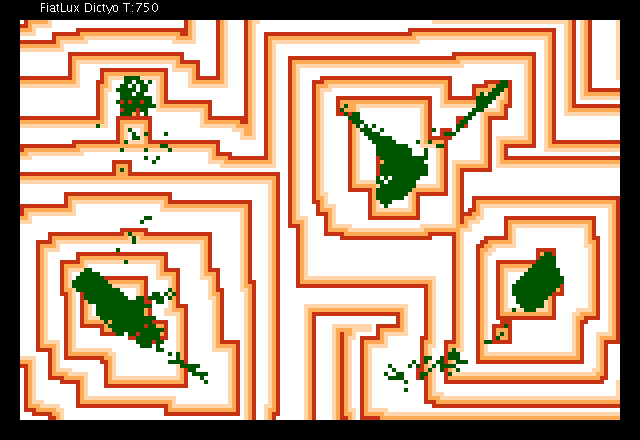AMYBIA
Aggregating MYriads of Biologically-Inspired Agents

This page provides a short presentation of the AMYBIA project.
This project was funded by the INRIA ARC 2008 program.
Keywords : complex systems, massively parallel computing schemes, bio-inspired modelling, robustness, decentralised gathering problem
The post-doctoral stay of N. Vlassopoulos is now over. We sincerley thank him for all the efforts he deployed to make this project a success!
Presentation
Our project involved the participation of:
Hugues Berry,
Alexandre Bury,
Nazim Fatès (leader),
Bernard Girau,
Nikolaos Vlassopoulos,
Guy Theraulaz.
The context of our collaboration is the definition of innovative schemes of decentralised and massively distributed computing.
We work at three levels:
-
At the modelling level, we think that biology provides us with complex and efficient models of such massively distributed behaviours. We start our study by addressing the decentralised gathering problem with the help of an original model of aggregation based on the behaviour of social amoebae.
learn more...
- At the simulation level, our research mainly relies on achieving large scale simulations and on obtaining large statistical samples. Mastering these simulations is a major scientific issue, especially considering the imposed constraints: distributed computations, parsimonious computing time and memory requirements. Furthermore its raises further problems, such as: how to handle asynchronism
[Fat04], randomness and statistical analysis?
learn more...
- At the hardware level, the challenge is to constantly confront our models with the actual constraints of a true practise of distributed computing. The main idea is to consider the hardware as a kind of sanity check. Hence, we intend to implement and validate our distributed models on massively parallel computing devices. In return, we expect that the analysis of the scientific issues raised by these implementations will influence the definition of the models themselves.
learn more...
Presentation of the model:
- Solving the decentralised gathering problem with a reaction-diffusion-chemotaxis scheme - Social amoebae as a source of inspiration ; Swarm Intelligence ; vol. 4 (2010) [doi]
- Clustering Behavior of a Bio-inspired Decentralized Aggregation Scheme;
Proceedings of ECAL 2011 (ext. abstr.) [preprint]
Study of the reaction-diffusion
- Robustness of the Critical Behaviour in the Stochastic Greenberg-Hastings Cellular Automaton Model; International Journal of Unconventional Computing; Vol 7; 2011 [preprint]
- Critical phenomena in a discrete stochastic reaction-diffusion medium ; Proceedings of IWNC'09 [preprint]
FPGA implementations of the reaction-diffusion CA:
- An FPGA design for the stochastic Greenberg-Hastings cellular automata ; Proceedings of HPCS 2010 [doi]
- Reaction-Diffusion and Chemotaxis for decentralized gathering on FPGAs ;
Int. Journal on Reconfigurable Computing ; 2009 [doi]
- Fast Implementation of a bio-inspired model for decentralized gathering; Proceedings of ReConFig'08 [download]
Implementation of the aggregation scheme on robots
- A Robust Aggregation Method for Quasi-blind Robots in an Active Environment ; Proceedings of ICSI 2011 [online publication]
Further information on this project
Open the page that describes our objectives
see the poster presented in the 2008 ARC meeting.
A two-year summary of the project was presented at the
ARC meeting which took place
in Bordeaux (France) : see the slides of the presentation [pdf, in French].
Download simulator
You can use the FiatLux CA simulator to test the model directly :
Download a pre-configured version.
You need Java to run the program.
Double-click to launch or type "java -jar FiatLux27VII07.jar" in a terminal window.
Numerical results of phase-transition localisation with FPGA experiments :
open page
|
